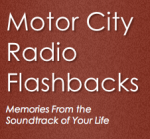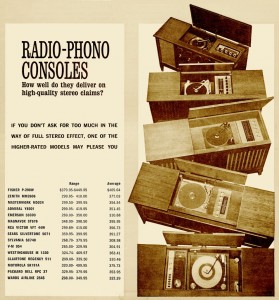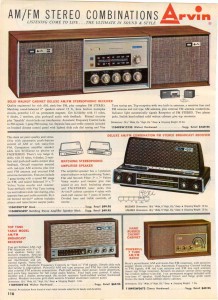Perry Como – Hot Diggity – 1956
![]()
 From the MCRFB news archive: 1965
From the MCRFB news archive: 1965
FM Radio Sales On Rise; Boom Forecast for ’66 – ’67
WILL FM BE TO RADIO what color is to TV?
Sales of FM radio has risen about 20 per cent each year in the last few years, while total radio sales have remained more or less “static” overall. There is now reason to believe that FM’s sales curve will increase more sharply in coming years, and it’s possible that by 1966 or 1967 we’ll be talking about the “FM boom” the way we talk about the “color boom.”

The FM radio production figures released by the Electronics Industries Association tell only about one-third of the story of FM’s rise, since they only include domestic brand table models, portables and clock radios. for the past five years it has been common practice to try to establish a reasonably accurate estimate of the total sales of “FM receiving devices” in the United States. This includes, in addition to simple radios, the number of component tuners, automobile FM sets, TV and phonograph-radio combinations and imports not included in domestic-label output.
In a Billboard column last August 15, it was estimated that FM sales for 1964 should hit about 6 million units, a 20 percent increase from the 5.1 million units of 1963. This is just about the way it turned out.
For 1965 it now appears that an increase of more than 25 percent — over 7.5 million units — is in prospect. Here are the estimates of 1964 sales of FM receiving devices, along with projected forecasts for 1965:
1964: Table, Clock and Portable – 2,100,000
1965: Table, Clock and Portable – 2,700,000
1964: Phono-radio combinations – 1,400,000
1965: Phono-radio combinations – 1,600,000
1964: Component tuners – 200,000
1965: Component tuners – 250,000
1964: Auto FM tuners – 460,000
1965: Auto FM tuners – 900,000
These figures are estimates, but they are currently the best available data where the FM trend is heading today. The forecasts for 1965 are based on where the radio medium is so far this year, along with some very solid indications of a further increase in FM’s share of the radio market.
The increase in the number of FM stations, the FCC edict calling for for separate large city FM-AM combinations (which, in effect, creates many new stations) the increased efforts by manufacturers and importers to merchandise FM radios because of higher profit margins — these all will have their effects. Taking up the various categories separately:
30 Per Cent Hike
There has been a 30 per cent increase in the table-clock portable (which also includes imports sold under domestic manufacturer’s names). This means that more than 25 per cent of all such radios sold this year will include FM.

The phono-radio combination field will see an increase of about 14 per cent in FM-equipped units. This is a continuation of the trend, spawned by the introduction of FM-stereo, to include AM-FM stereo tuners or at least AM-FM mono tuners in all but the low-end combinations. More that 80 per cent of all console phonographs should have FM this year. Some major manufacturers no longer offer stereo console players without FM.
The component tuner category is an estimated guess, based on Census Bureau figures allocated for 1963 and numbers provided by manufacturers. It is estimated there will be a 25 per cent increase overall projected in this market.
In the automotive sector, the numbers have vastly increased in the automobile FM figures because of evidence that sales actually approached a half million last year. Most luxury cars — including Cadillac,Continental, Imperial and Corvette — were sold with FM radios, and FM became an accessory for most makes last year. Many Volkswagen and other German cars were sold with Blaupunkt FM-AM radios, and a sizeable after-market is developing. The number should double this year, due to the influence of enthusiastic home FM owners, a steady push by auto makers and continuing development of after-market sales.
The import portable, table-top model, clock-radio, transistor radio category consist mainly of Japanese-brand portables. Japanese manufacturers and American importers are pushing FM portables in an attempt to put profit back in transistor radios. It’s a reliable estimate that more than 15 per cent of Japan to U. S. radio shipments last year were FM sets. This year both importers and officials of the EIA of Japan predict that the total figure will be closer to 20 per cent increase in the number of FM radio imports.
The increasing proportion of FM sales can mean increased profit margins for dealers. And another known indicator is that FM radios resell themselves. The family with one FM set usually wants another.
As the FM boom gathers steam, it’s not only conceivable, but probable, that the majority of radio sales will be in the FM category — probably some time within the next five years. END
___
(Information and news source: Billboard; May 1, 1965)


![]()
Listen to some great oldies with
Jimmy James
IN THE MORNING
On WCXI * 1160 AM Fenton
![]()
Births
1918: Eddy Arnold
1937: Trini Lopez
1938: Lenny Welch
1944: Ian Amey (Dave Dee, Dozey, Beaky, Mick and Tich)
1947: Graham Goble (The Little River Band)
1948: Gary Thain (Uriah Heep)
1948: Brian Eno
1953: Mike Oldfield
Deaths
1992: Barbara Lee Jones (The Chiffons)
2000: Geoff Goddard (The Tornadoes)
2001: Brian Pendleton (The Pretty Things)
2003: June Carter Cash
Events
1954: A Memphis truck driver named Elvis Presley auditions with the house band at Memphis’ Hi Hat Club and is told he’ll never make it as a singer.
1961: Brenda Lee guest stars as struggling singer “Tina Davis” on tonight’s “Teenage Thrush” episode of CBS-TV’s Make Room For Daddy.
1963: The Rolling Stones sign to Decca Records.
1963: At the 5th Annual Grammy Awards, most of the big prizes go to Henry Mancini for his instrumental movie theme “The Days Of Wine And Roses.” Best Album and Best Female Vocal go to The Barbra Streisand Album, while Nino Tempo and April Stevens inexplicably win Best Rock and Roll Recording for “Deep Purple.” However, Ray Charles does win the top R&B award for “Busted.”
1967: While attending a concert by Georgie Fame and the Blue Flames at London’s ultrahip Bag O’Nails club, Paul McCartney meets a young photographer named Linda Eastman. They will meet again one year later to the day when Paul appears with John on NBC-TV’s Tonight Show to talk about their upcoming venture, Apple Records.
1971: Pink Floyd play London’s Crystal Palace Bowl, situated in front of a large lake in which, thanks to the band’s volume, most of the fish will die.
1973: Former Boz Scaggs and Elvin Bishop backup singers the Pointer Sisters make their stage debut as an act of their own, singing at the Troubadour in Los Angeles.
1975: The latest and ultimately most famous lineup of Fleetwood Mac — Mick Fleetwood, John McVie, Christine McVie, Lindsey Buckingham, and Stevie Nicks — play their first show together in El Paso.
1977: Procol Harum plays what will prove to be their last live show at the Academy of Music in New York.
1986: Bob Dylan signs for his first true acting gig, the disastrous love triangle Hearts Of Fire, also starring Rupert Everett and future pop-metal afterthought Fiona.
1996: The earliest-ever footage of the Beatles, found in a Liverpool home, was broadcast by Britain’s ITV; it shows the group (minus sound) performing at the Casanova Club on February 14, 1961.
1997: Muzak turns four KISS hits, inexplicably, into its patented “beautiful music” instrumentals.
2009: Randy Bachman of the Guess Who and Bachman-Turner Overdrive is presented with Canada’s highest civilian honor, an officer of the Order of Canada.
Releases
1970: The Carpenters, Close To You
1970: Black Sabbath, Black Sabbath
Recording
1972: The Temptations, “Papa Was A Rollin’ Stone”
Charts
1965: The Byrds’ “Mr. Tambourine Man” enters the charts
1971: Crosby, Stills, Nash and Young’s LP 4 Way Street hits #1
1976: The Rolling Stones LP Black And Blue hits #1
1976: The Sylvers’ “Boogie Fever” hits #1
Certifications
1972: Glen Campbell’s Greatest Hits LP is certified gold
![]()
I dreamed a dream in time gone by
When hope was high and life worth living
I dreamed that love would never die
I dreamed that God would be forgiving
Then I was young and unafraid
And dreams were made and used and wasted
There was no ransom to be paid
No song unsung, no wine untasted
But the tigers come at night
With their voices soft as thunder
As they tear your hopes apart
And they turn your dream to shame
Still I dream he’d come to me
That we would live the years together
But there are dreams that cannot be
And there are storms we cannot weather
I had a dream my life would be
So different from this hell I’m living
So different now from what it seems
Now life has killed the dream I dreamed
![]()